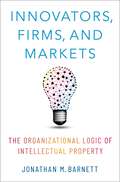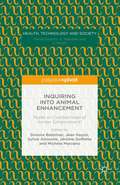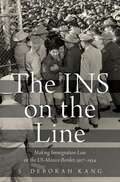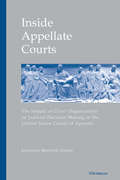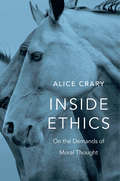- Table View
- List View
Innovatives Regionalmanagement im demografischen Wandel (Stadtforschung aktuell)
by Ralf Kleinfeld Joachim Hafkesbrink Jens StuhldreierDer Sammelband thematisiert den demografischen Wandel als Megatrend, der Regionen sehr unterschiedlich und immer wieder neu herausfordert. Wirtschaft und Arbeit sind dabei zentrale Gestaltungsfelder. Das Buch fasst die Ergebnisse eines vom BMBF 2014-2016 geförderten Projektes zusammen, das durch die Zusammenführung von Regional Governance und Transition Management ein innovatives Regionalmanagement entwickelt hat, welches den Akteuren in der Region hilft, den demografischen Wandel zu gestalten.
Innovators, Firms, and Markets: The Organizational Logic of Intellectual Property
by Jonathan M. BarnettConventional wisdom holds that robust enforcement of intellectual property (IP) right suppress competition and innovation by shielding incumbents against the entry threats posed by smaller innovators. That assumption has driven mostly successful efforts to weaken US patent protections for over a decade. This book challenges that assumption. In Innovators, Firms, and Markets, Jonathan M. Barnett confronts the reigning policy consensus by analyzing the relationship between IP rights, firm organization, and market structure. Integrating tools and concepts from IP and antitrust law, institutional economics, and political science, real-world understandings of technology markets, and empirical insights from the economic history of the US patent system, Barnett provides a novel framework for IP policy analysis. His cohesive framework explains how robust enforcement of IP rights enables entrepreneurial firms, which are rich in ideas but poor in capital, to secure outside investment and form the cooperative relationships needed to transform a breakthrough innovation into a marketable product. The history of the US patent system and firms' lobbying tendencies show that weakening patent protections removes a critical tool for entrants to challenge incumbents that enjoy difficult-to-match commercialization and financing capacities. Counterintuitively, the book demonstrates that weak IP rights are often the best entry barrier the state can provide to protect entrenched incumbents against disruptive innovators. By challenging common assumptions and offering a powerful integrated framework for understanding how innovation happens and the law's role in that process, Barnett's Innovators, Firms, and Markets provides important insights into how IP law shapes our economy.
Innovators, Firms, and Markets: The Organizational Logic of Intellectual Property
by Jonathan M. BarnettConventional wisdom holds that robust enforcement of intellectual property (IP) right suppress competition and innovation by shielding incumbents against the entry threats posed by smaller innovators. That assumption has driven mostly successful efforts to weaken US patent protections for over a decade. This book challenges that assumption. In Innovators, Firms, and Markets, Jonathan M. Barnett confronts the reigning policy consensus by analyzing the relationship between IP rights, firm organization, and market structure. Integrating tools and concepts from IP and antitrust law, institutional economics, and political science, real-world understandings of technology markets, and empirical insights from the economic history of the US patent system, Barnett provides a novel framework for IP policy analysis. His cohesive framework explains how robust enforcement of IP rights enables entrepreneurial firms, which are rich in ideas but poor in capital, to secure outside investment and form the cooperative relationships needed to transform a breakthrough innovation into a marketable product. The history of the US patent system and firms' lobbying tendencies show that weakening patent protections removes a critical tool for entrants to challenge incumbents that enjoy difficult-to-match commercialization and financing capacities. Counterintuitively, the book demonstrates that weak IP rights are often the best entry barrier the state can provide to protect entrenched incumbents against disruptive innovators. By challenging common assumptions and offering a powerful integrated framework for understanding how innovation happens and the law's role in that process, Barnett's Innovators, Firms, and Markets provides important insights into how IP law shapes our economy.
The Inquest Book: The Law of Coroners and Inquests
by Clodagh Bradley Peter Skelton Rachel Marcus Kate Beattie Matthew Hill Caroline Cross Neil GarnhamCoronial Law is an area that attracts great public scrutiny, reflected in the recent establishment of the office of the Chief Coroner, and the number of Judges of the High Court and the Court of Appeal made deputy assistant coroners to particularly sensitive inquests. It is also an area of law that has changed significantly in recent years since the new Coroners and Justice Act 2009 came into force in 2013.This book provides practitioners with an up-to-date and comprehensive guide to the law of coroners and inquests. Written by barristers practising in the field, it addresses changes to the structure and jurisprudence of coroners' courts in a straightforward, accessible manner. The book is helpfully structured according to the elements of an inquest or the subject matter of a coroner's investigation. Each chapter provides an overview of the legal issues, statutory material and other sources of guidance, followed by case summaries and extracts where the relevant issues are discussed. In addition, there are useful appendices of relevant materials, including applicable legislation and the Chief Coroner's Guidance. The book is an essential companion for practitioners of coronial law, indispensable to novices and seasoned practitioners alike.
The Inquest Book: The Law of Coroners and Inquests
by Peter Skelton Rachel Marcus Kate Beattie Matthew HillCoronial Law is an area that attracts great public scrutiny, reflected in the recent establishment of the office of the Chief Coroner, and the number of Judges of the High Court and the Court of Appeal made deputy assistant coroners to particularly sensitive inquests. It is also an area of law that has changed significantly in recent years since the new Coroners and Justice Act 2009 came into force in 2013.This book provides practitioners with an up-to-date and comprehensive guide to the law of coroners and inquests. Written by barristers practising in the field, it addresses changes to the structure and jurisprudence of coroners' courts in a straightforward, accessible manner. The book is helpfully structured according to the elements of an inquest or the subject matter of a coroner's investigation. Each chapter provides an overview of the legal issues, statutory material and other sources of guidance, followed by case summaries and extracts where the relevant issues are discussed. In addition, there are useful appendices of relevant materials, including applicable legislation and the Chief Coroner's Guidance. The book is an essential companion for practitioners of coronial law, indispensable to novices and seasoned practitioners alike.
Inquests (Criminal Law Library)
by John CooperThe last year has seen the largest and most comprehensive reform of Coronial Law since the early nineteenth century. The new Coroners and Justice Act 2009 impacts upon every aspect of the Inquest and this comprehensive new work lays out both the substantive law and new procedure following the recent legislation and authorities.The whole coronial process is laid out in distinct chapters which consider the present and developing law.The book provides practical guidance from the beginning to the end of the process and includes a special chapter on Military inquests, creating an invaluable reference for both the practitioner and student of this fast developing area of law.
Inquiring into Animal Enhancement: Model or Countermodel of Human Enhancement? (Health, Technology and Society)
by Jean Gayon Simone Bateman Sylvie Allouche Jérôme Goffette Michela MarzanoThis book explores issues raised by past and present practices of animal enhancement in terms of their means and their goals, clarifies conceptual issues and identifies lessons that can be learned about enhancement practices, as they concern both animals and humans.
An Inquiry-Based Introduction to Engineering
by Michelle BlumThe text introduces engineering to first-year undergraduate students using Inquiry-Based Learning (IBL). It draws on several different inquiry-based instruction types such as confirmation inquiry, structured inquiry, guided inquiry, and open inquiry, and all of their common elements. Professor Blum’s approach emphasizes the student’s role in the learning process, empowering them in the classroom to explore the material, ask questions, and share ideas, instead of the instructor lecturing to passive learners about what they need to know. Beginning with a preface to IBL, the book is organized into three parts, each consisting of four to ten chapters. Each chapter has a dedicated topic where an initial few paragraphs of introductory or fundamental material are provided. This is followed by a series of focused questions that guide the students’ learning about the concept(s) being taught. Featuring multiple inquiry-based strategies, each most appropriate to the topic, An Inquiry-Based Approach to Introduction to Engineering stands as an easy to use textbook that quickly allows students to actively engage with the content during every class period.
An Inquiry into the Existence of Global Values: Through the Lens of Comparative Constitutional Law
by Dennis Davis Alan Richter Cheryl SaundersThe world appears to be globalising economically, technologically and even, to a halting extent, politically. This process of globalisation raises the possibility of an international legal framework, a possibility which has gained pressing relevance in the wake of the recent global economic crisis. But for any international legal framework to exist, normative agreement between countries, with very different political, economic, cultural and legal traditions, becomes necessary. This work explores the possibility of such a normative agreement through the prism of national constitutional norms. Since 1945, more than a hundred countries have adopted constitutional texts which incorporate, at least in part, a Bill of Rights. These texts reveal significant similarities; the Canadian Charter of Rights and Freedoms, for instance, had a marked influence on the drafting of the Bill of Rights for South Africa, New Zealand and Hong Kong as well as the Basic Law of Israel. Similarly, the drafts of Eastern European constitutions reflect significant borrowing from older texts. The essays in this book examine the depth of these similarities; in particular the extent to which textual borrowings point to the development of foundational values in these different national legal systems and the extent of the similarities or differences between these values and the priorities accorded to them. From these national studies the work analyses the rise of constitutionalism since the Second World War, and charts the possibility of a consensus on values which might plausibly underpin an effective and legitimate international legal order.
An Inquiry into the Existence of Global Values: Through the Lens of Comparative Constitutional Law (Hart Studies In Comparative Public Law Ser. #7)
by Dennis Davis Alan Richter Cheryl SaundersThe world appears to be globalising economically, technologically and even, to a halting extent, politically. This process of globalisation raises the possibility of an international legal framework, a possibility which has gained pressing relevance in the wake of the recent global economic crisis. But for any international legal framework to exist, normative agreement between countries, with very different political, economic, cultural and legal traditions, becomes necessary. This work explores the possibility of such a normative agreement through the prism of national constitutional norms. Since 1945, more than a hundred countries have adopted constitutional texts which incorporate, at least in part, a Bill of Rights. These texts reveal significant similarities; the Canadian Charter of Rights and Freedoms, for instance, had a marked influence on the drafting of the Bill of Rights for South Africa, New Zealand and Hong Kong as well as the Basic Law of Israel. Similarly, the drafts of Eastern European constitutions reflect significant borrowing from older texts. The essays in this book examine the depth of these similarities; in particular the extent to which textual borrowings point to the development of foundational values in these different national legal systems and the extent of the similarities or differences between these values and the priorities accorded to them. From these national studies the work analyses the rise of constitutionalism since the Second World War, and charts the possibility of a consensus on values which might plausibly underpin an effective and legitimate international legal order.
The INS on the Line: Making Immigration Law on the US-Mexico Border, 1917-1954
by S. Deborah KangFor much of the twentieth century, Immigration and Naturalization Service (INS) officials recognized that the US-Mexico border region was different. Here, they confronted a set of political, social, and environmental obstacles that prevented them from replicating their achievements on Angel Island and Ellis Island, the most restrictive immigration stations in the nation. In response to these challenges, local INS officials resorted to the law, nullifying, modifying, and creating the nation's immigration laws and policies for the borderlands. In The INS on the Line, S. Deborah Kang traces the ways in which the INS on the US-Mexico border made and remade the nation's immigration laws over the course of the twentieth century. Through a nuanced examination of the agency's legal innovations in the Southwest, Kang demonstrates that the agency defined itself not only as a law enforcement unit but also as a lawmaking body. In this role, the INS responded to the interests of local residents, businesses, politicians, and social organizations on both sides of the US-Mexico border as well as policymakers in Washington, DC. Given the sheer variety of local and federal demands, local immigration officials constructed a complex approach to border control, an approach that closed the line in the name of nativism and national security, opened it for the benefit of transnational economic and social concerns, and redefined it as a vast legal jurisdiction for the policing of undocumented immigrants. The composite approach to border control developed by the INS continues to inform the daily operations of the nation's immigration agencies, American immigration law and policy, and conceptions of the US-Mexico border today.
INS ON THE LINE C: Making Immigration Law on the US-Mexico Border, 1917-1954
by S. Deborah KangFor much of the twentieth century, Immigration and Naturalization Service (INS) officials recognized that the US-Mexico border region was different. Here, they confronted a set of political, social, and environmental obstacles that prevented them from replicating their achievements on Angel Island and Ellis Island, the most restrictive immigration stations in the nation. In response to these challenges, local INS officials resorted to the law, nullifying, modifying, and creating the nation's immigration laws and policies for the borderlands. In The INS on the Line, S. Deborah Kang traces the ways in which the INS on the US-Mexico border made and remade the nation's immigration laws over the course of the twentieth century. Through a nuanced examination of the agency's legal innovations in the Southwest, Kang demonstrates that the agency defined itself not only as a law enforcement unit but also as a lawmaking body. In this role, the INS responded to the interests of local residents, businesses, politicians, and social organizations on both sides of the US-Mexico border as well as policymakers in Washington, DC. Given the sheer variety of local and federal demands, local immigration officials constructed a complex approach to border control, an approach that closed the line in the name of nativism and national security, opened it for the benefit of transnational economic and social concerns, and redefined it as a vast legal jurisdiction for the policing of undocumented immigrants. The composite approach to border control developed by the INS continues to inform the daily operations of the nation's immigration agencies, American immigration law and policy, and conceptions of the US-Mexico border today.
Insane: America's Criminal Treatment Of Mental Illness
by Alisa RothAn urgent exposé of the mental health crisis in our courts, jails, and prisons America has made mental illness a crime. Jails in New York, Los Angeles, and Chicago each house more people with mental illnesses than any hospital. Across America, as many as half of all inmates have a psychiatric problem. One in four fatal police shootings involves a person with such disorders. In this revelatory book, journalist Alisa Roth goes deep inside the criminal justice system to show how and why it has become a warehouse where inmates are denied proper treatment, abused, and punished in ways that make them sicker. Through intimate stories of people in the system and those trying to fix it, Roth reveals the hidden forces behind this crisis and suggests how a fairer and more humane approach might look. Insane is a galvanizing wake-up call for criminal justice reformers and anyone concerned about the plight of our most vulnerable.
The Insanity Defence: International and Comparative Perspectives (Oxford Monographs on Criminal Law and Justice)
by Ronnie Mackay and Warren BrookbanksMore than any other defence in the criminal law, the insanity defence has, and continues to be, the subject of heated debate. Yet too little is known about how the insanity defence operates in different jurisdictions, including in the United Kingdom and Ireland. In this book, Mackay and Brookbanks, and their team of expert contributors, explore the theory and practice around the insanity defence and analyse its diverse influence and manifestations across a wide range of common law and civil law jurisdictions. Typically, the insanity defence, as exemplified in the M'Naghten Rules, represents a foundational aspect of criminal responsibility, although in some jurisdictions it serves only to define degrees of mental capacity. However, what all jurisdictions have in common is the high and increasing incidence of mental illness and impairment challenging existing constructions of an exculpatory rule. This book explores in detail the origins and operation of the M'Naghten Rules as well as the eclectic nature of the insanity defence, its highly variable linguistic expression, and the diverse social policy mandates it seeks to embrace. The Insanity Defence will reinvigorate the debate about the defence by discussing both its theoretical basis and exploring how different jurisdictions approach the insanity plea, not only in relation to an appropriate test and how it operates, but also from the perspective of disposal and how those who use the insanity defence successfully are dealt with. This book will be of interest to researchers, academics, and advanced students with an interest in criminal law internationally, as well as to those involved in the development of policy and legislation.
The Insanity Defence: International and Comparative Perspectives (Oxford Monographs on Criminal Law and Justice)
More than any other defence in the criminal law, the insanity defence has, and continues to be, the subject of heated debate. Yet too little is known about how the insanity defence operates in different jurisdictions, including in the United Kingdom and Ireland. In this book, Mackay and Brookbanks, and their team of expert contributors, explore the theory and practice around the insanity defence and analyse its diverse influence and manifestations across a wide range of common law and civil law jurisdictions. Typically, the insanity defence, as exemplified in the M'Naghten Rules, represents a foundational aspect of criminal responsibility, although in some jurisdictions it serves only to define degrees of mental capacity. However, what all jurisdictions have in common is the high and increasing incidence of mental illness and impairment challenging existing constructions of an exculpatory rule. This book explores in detail the origins and operation of the M'Naghten Rules as well as the eclectic nature of the insanity defence, its highly variable linguistic expression, and the diverse social policy mandates it seeks to embrace. The Insanity Defence will reinvigorate the debate about the defence by discussing both its theoretical basis and exploring how different jurisdictions approach the insanity plea, not only in relation to an appropriate test and how it operates, but also from the perspective of disposal and how those who use the insanity defence successfully are dealt with. This book will be of interest to researchers, academics, and advanced students with an interest in criminal law internationally, as well as to those involved in the development of policy and legislation.
The Insanity Defense: Multidisciplinary Views on Its History, Trends, and Controversies
by Mark D. White, EditorHow often is the defense of insanity or temporary insanity for accused criminals valid—or is it ever legitimate? This unique work presents multidisciplinary viewpoints that explain, support, and critique the insanity defense as it stands.What is the role of "the insanity defense" as a legal excuse? How does U.S. law handle criminal trials where the defendant pleads insanity, and how does our legal system's treatment differ from those of other countries or cultures? How are insanity defenses used, and how successful are these defenses for the accused? What are the costs of incarceration versus psychiatric treatment and confinement?This book presents a range of expert viewpoints on the insanity defense, exposing common myths; investigating its effectiveness and place in our legal system through history, case studies, and comparative analysis; and supplying perspectives from the disciplines of psychology, psychiatry, sociology, and neuroscience. The content also addresses the ramifications of declaring citizens insane or incapacitated and examines trials that involved pleas of insanity and temporary insanity.
The Insanity Defense: Multidisciplinary Views on Its History, Trends, and Controversies
by Mark D. WhiteHow often is the defense of insanity or temporary insanity for accused criminals valid—or is it ever legitimate? This unique work presents multidisciplinary viewpoints that explain, support, and critique the insanity defense as it stands.What is the role of "the insanity defense" as a legal excuse? How does U.S. law handle criminal trials where the defendant pleads insanity, and how does our legal system's treatment differ from those of other countries or cultures? How are insanity defenses used, and how successful are these defenses for the accused? What are the costs of incarceration versus psychiatric treatment and confinement?This book presents a range of expert viewpoints on the insanity defense, exposing common myths; investigating its effectiveness and place in our legal system through history, case studies, and comparative analysis; and supplying perspectives from the disciplines of psychology, psychiatry, sociology, and neuroscience. The content also addresses the ramifications of declaring citizens insane or incapacitated and examines trials that involved pleas of insanity and temporary insanity.
The Insanity Defense: A Philosophical Analysis (Elgar Studies in Legal Theory)
by Wojciech ZałuskiThis unique book provides a versatile exploration of the philosophical foundations of the insanity defense. It examines the connections between numerous philosophical-anthropological views and analyses different methods for regulating the criminal responsibility of the mentally ill. Placing its philosophical analysis firmly in the context of science, it draws on the fields of cognitive psychology, evolutionary theory and criminology.In this thought-provoking book, Wojciech Zaluski argues that the way in which we resolve the problem of the criminal responsibility of the mentally ill depends on two factors: the assumed conception of responsibility and the account of mental illness. Offering a systematic and in-depth analysis of the influence of anti-psychiatry on thinking about the insanity defense and legislation, the author invokes the personalist view of human nature, being rational and endowed with free will, to justify an original normative proposal concerning the construction of the insanity defense.The Insanity Defense will be of primary interest to scholars of criminal law and justice, legal theory and legal philosophy as well as legal practitioners, policy makers, psychiatrists and psychologists engaged with this topic.
Inscribed Bodies: Health Impact of Childhood Sexual Abuse
by Anna Luise KirkengenThis book contributes to an overall understanding of the nature and the impact of sexual boundary violations. By exploring an extreme human experience, childhood sexual abuse, the present study allows an insight into a hidden, silenced, and destructive aspect of human relations. It is the first of its kind to make comprehensible both the general path from violation to sickness, and the particular logic of assault embodiment. Due to its theoretical and methodological framework, the present study provides evidence that the embodiment of sexual violation experience is informed by situated logic and rationality. These, however, do not correspond to scientific logic and rationality. The universe of socio-culturally constituted meaning and that of scientifically constructed knowledge are shown to be incompatible. Subjectively informed violation embodiment is likely to be misinterpreted and consequently maltreated within the objectively grounded framework of current biomedical praxis. Consequently, victims of silenced sexual violence are revictimized by medicine.
Inside Appellate Courts: The Impact of Court Organization on Judicial Decision Making in the United States Courts of Appeals
by Jonathan M. CohenInside Appellate Courts is a comprehensive study of how the organization of a court affects the decisions of appellate judges. Drawing on interviews with more than seventy federal appellate judges and law clerks, Jonathan M. Cohen challenges the assumption that increasing caseloads and bureaucratization have impinged on judges' abilities to bestow justice. By viewing the courts of appeals as large-scale organizations, Inside Appellate Courts shows how courts have walked the tightrope between justice and efficiency to increase the number of cases they decide without sacrificing their ability to dispense a high level of justice. Cohen theorizes that, like large corporations, the courts must overcome the critical tension between the autonomy of the judges and their interdependence and coordination. However, unlike corporations, courts lack a central office to coordinate the balance between independence and interdependence. Cohen investigates how courts have dealt with this tension by examining topics such as the role of law clerks, methods of communication between judges, the effect of a court's size and geographic location, the role of argumentation, the use of visiting judges, the significance of the increasing use of unpublished decisions, and the nature and role of court culture. Inside Appellate Courts offers the first comprehensive organizational study of the appellate judicial process. It will be of interest to the social scientist studying organizations, the sociology of law, and comparative dispute resolution and have a wide appeal to the legal audience, especially practicing lawyers, legal scholars, and judges. Jonathan M. Cohen is Attorney at Gilbert, Heintz, and Randolph LLP.
Inside Apple: Das Erfolgsgeheimnis des wertvollsten, innovativsten und verschwiegensten Unternehmensder Welt
by Adam LashinskyApple ist seit dem 20. August 2012 das wertvollste Unternehmen der Welt. "Inside Apple" enthüllt das geheime System, die Taktiken und die Führungsstrategien, die Steve Jobs und seinem Unternehmen erlaubten, ein Erfolgsprodukt nach dem anderen zu produzieren und eine kultähnliche Anhängerschaft für seine Produkte zu erwecken. In diesem Referenzwerk zur Unternehmensführung stellt Adam Lashinsky dem Leser Konzepte wie das des "DRI" (Apples Praxis, jeder Aufgabe einen "Directly Responsible Individual", also einen direkt und unmittelbar Verantwortlichen zuzuweisen) und das der Top 100 (ein jährlich wiederkehrendes Ritual, bei dem 100 aufstrebende Führungskräfte für ein geheimes, vollständig abgeschirmtes Treffen mit Unternehmensgründer Steve Jobs ausgewählt und auf Herz und Nieren überprüft werden) vor. Basierend auf zahllosen Interviews bietet das Buch exklusiv neue Informationen darüber, wie Apple Innovationen schafft, mit Lieferanten umgeht und den Übergang in die Post-Jobs-Ära handhabt. Adam Lashinsky kennt Apple durch und durch: Bereits 2008 sagte er in einer Titelstory ("The Genius Behind Steve: Could Operations Whiz Tim Cook Run The Company Someday?") für das Magazin Fortune voraus, dass der damals noch unbekannte Tim Cook eventuell Steve Jobs als CEO nachfolgen würde. Obwohl "Inside Apple" vordergründig ein tiefer Einblick in ein einzigartiges Unternehmen (und in sein Ökosystem aus Lieferanten, Investoren, Angestellten und Wettbewerbern) ist, sind die Lehren über Steve Jobs, Unternehmensführung, Produktdesign und Marketing allgemeingültig. Sie sollten von jedem gelesen werden, der einen Teil der Apple-Magie in sein Unternehmen, seine Karriere oder sein kreatives Bestreben bringen möchte.
Inside Asylum Appeals: Access, Participation and Procedure in Europe (Law and Migration)
by Daniel Fisher Nick Gill Nicole Hoellerer Jessica HamblyAppeals are a crucial part of Europe’s asylum system but they remain poorly understood. Building on insights and perspectives from legal geography and socio-legal studies, this book shines a light on what takes place during asylum appeals and puts forward suggestions for improving their fairness and accessibility. Drawing on hundreds of ethnographic observations of appeal hearings, as well as research interviews, the authors paint a detailed picture of the limitations of refugee protection available through asylum appeals. Refugee law can appear dependable and reliable in policy documents and legal texts. However, this work reveals that, in reality, myriad social, political, psychological, linguistic, contextual and economic factors interfere with and frequently confound the protection that refugee law promises during its concrete enactment. Drawing on evidence from Austria, Belgium, France, Germany, Greece, Italy and the United Kingdom, the book equips readers with a clear sense of the fragility of legal protection for people forced to migrate to Europe. The book will appeal to scholars of migration studies, legal studies, legal geography and the social sciences generally, as well as practitioners in asylum law throughout Europe and beyond.This book is freely available as a downloadable Open Access PDF at http://www.taylorfrancis.com under a Creative Commons Attribution-Non Commercial-No Derivatives (CC-BY-NC-ND) 4.0 license.
Inside Asylum Appeals: Access, Participation and Procedure in Europe (Law and Migration)
by Daniel Fisher Nick Gill Nicole Hoellerer Jessica HamblyAppeals are a crucial part of Europe’s asylum system but they remain poorly understood. Building on insights and perspectives from legal geography and socio-legal studies, this book shines a light on what takes place during asylum appeals and puts forward suggestions for improving their fairness and accessibility. Drawing on hundreds of ethnographic observations of appeal hearings, as well as research interviews, the authors paint a detailed picture of the limitations of refugee protection available through asylum appeals. Refugee law can appear dependable and reliable in policy documents and legal texts. However, this work reveals that, in reality, myriad social, political, psychological, linguistic, contextual and economic factors interfere with and frequently confound the protection that refugee law promises during its concrete enactment. Drawing on evidence from Austria, Belgium, France, Germany, Greece, Italy and the United Kingdom, the book equips readers with a clear sense of the fragility of legal protection for people forced to migrate to Europe. The book will appeal to scholars of migration studies, legal studies, legal geography and the social sciences generally, as well as practitioners in asylum law throughout Europe and beyond.This book is freely available as a downloadable Open Access PDF at http://www.taylorfrancis.com under a Creative Commons Attribution-Non Commercial-No Derivatives (CC-BY-NC-ND) 4.0 license.
Inside Ethics: On the Demands of Moral Thought
by Alice CraryAlice Crary offers a transformative account of moral thought about human beings and animals. Instead of assuming that the world places no demands on our moral imagination, she underscores the urgency of treating the exercise of moral imagination as necessary for arriving at an adequate world-guided understanding of human beings and animals.
Inside Ethics: On the Demands of Moral Thought
by Alice CraryAlice Crary offers a transformative account of moral thought about human beings and animals. Instead of assuming that the world places no demands on our moral imagination, she underscores the urgency of treating the exercise of moral imagination as necessary for arriving at an adequate world-guided understanding of human beings and animals.

